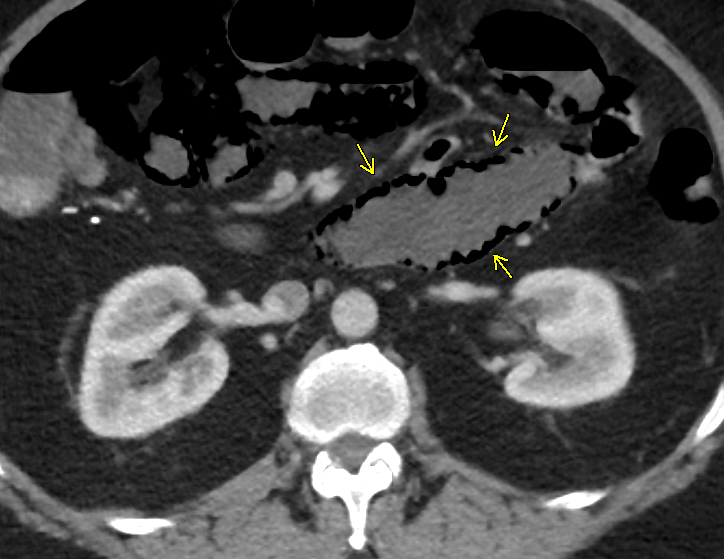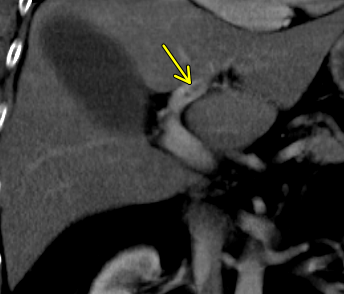Tuesday Poster Session
Category: Diet, Nutrition, and Obesity
P4854 - Semaglutide-Associated Portal Vein Thrombosis: A Rare Vascular Complication
Tuesday, October 28, 2025
10:30 AM - 4:00 PM PDT
Location: Exhibit Hall
- VP
Vishakh Prakash, MD (he/him/his)
Texas Tech University Health Sciences Center
El Paso, TX
Presenting Author(s)
Vishakh Prakash, MD1, Sumedha Nediyirippil Unnikrishnan, MD1, Bansi Sutariya, MD2, Azucena Del-Real, MD2, Vamsi Kunam, MD1
1Texas Tech University Health Sciences Center, El Paso, TX; 2Paul L. Foster School of Medicine, Texas Tech University Health Sciences Center, El Paso, TX
Introduction: Semaglutide, a glucagon-like peptide-1 receptor agonist (GLP-1 RA) approved for obesity and type 2 diabetes, is commonly associated with gastrointestinal adverse effects; however, its vascular complications are not well characterized. While thrombotic events remain rare, isolated cases of splanchnic venous thrombosis have been reported. We present a case of portal vein thrombosis in a patient on semaglutide with significant recent weight loss and an improving metabolic profile, raising concern for a potential drug-related effect.
Case Description/
Methods: A 56-year-old obese male with no thrombotic history presented with two weeks of nausea, bilious vomiting, diffuse abdominal pain, and non-bloody diarrhea. Symptoms began shortly after his semaglutide dose was increased to 2.4 mg weekly. He had recently lost 25 pounds over six months and was engaging in regular physical activity. He was hemodynamically stable with normal lactate. CT imaging revealed pneumatosis intestinalis, concerning for early intestinal ischemia, and a portal vein filling defect. Doppler ultrasound confirmed diminished hepatopedal flow consistent with partial portal vein thrombosis. He was managed conservatively with bowel rest, IV fluids, and therapeutic anticoagulation, while semaglutide was held, given the temporal relationship.
Discussion: This case raises concern for a possible association between semaglutide and venous thrombosis, particularly in the setting of gastrointestinal intolerance and dehydration. Although obesity is a known prothrombotic state, our patient had demonstrated reduced risk with sustained weight loss and increased physical activity. No other provoking factors or hypercoagulable states were identified. The close temporal association with semaglutide dose escalation supports a potential drug effect. Prior reports of splanchnic thrombosis with GLP-1 RA suggest this may be an underrecognized complication. Physicians should consider vascular events in patients with persistent gastrointestinal symptoms while on semaglutide, especially following dose escalation.

Figure: Coronal contrast-enhanced CT image demonstrating a partially occlusive thrombus in the left portal vein (arrow)

Figure: Axial contrast-enhanced CT image showing pneumatosis intestinalis involving the proximal small bowel, suggestive of early intestinal ischemia (arrows).
Disclosures:
Vishakh Prakash indicated no relevant financial relationships.
Sumedha Nediyirippil Unnikrishnan indicated no relevant financial relationships.
Bansi Sutariya indicated no relevant financial relationships.
Azucena Del-Real indicated no relevant financial relationships.
Vamsi Kunam indicated no relevant financial relationships.
Vishakh Prakash, MD1, Sumedha Nediyirippil Unnikrishnan, MD1, Bansi Sutariya, MD2, Azucena Del-Real, MD2, Vamsi Kunam, MD1. P4854 - Semaglutide-Associated Portal Vein Thrombosis: A Rare Vascular Complication, ACG 2025 Annual Scientific Meeting Abstracts. Phoenix, AZ: American College of Gastroenterology.
1Texas Tech University Health Sciences Center, El Paso, TX; 2Paul L. Foster School of Medicine, Texas Tech University Health Sciences Center, El Paso, TX
Introduction: Semaglutide, a glucagon-like peptide-1 receptor agonist (GLP-1 RA) approved for obesity and type 2 diabetes, is commonly associated with gastrointestinal adverse effects; however, its vascular complications are not well characterized. While thrombotic events remain rare, isolated cases of splanchnic venous thrombosis have been reported. We present a case of portal vein thrombosis in a patient on semaglutide with significant recent weight loss and an improving metabolic profile, raising concern for a potential drug-related effect.
Case Description/
Methods: A 56-year-old obese male with no thrombotic history presented with two weeks of nausea, bilious vomiting, diffuse abdominal pain, and non-bloody diarrhea. Symptoms began shortly after his semaglutide dose was increased to 2.4 mg weekly. He had recently lost 25 pounds over six months and was engaging in regular physical activity. He was hemodynamically stable with normal lactate. CT imaging revealed pneumatosis intestinalis, concerning for early intestinal ischemia, and a portal vein filling defect. Doppler ultrasound confirmed diminished hepatopedal flow consistent with partial portal vein thrombosis. He was managed conservatively with bowel rest, IV fluids, and therapeutic anticoagulation, while semaglutide was held, given the temporal relationship.
Discussion: This case raises concern for a possible association between semaglutide and venous thrombosis, particularly in the setting of gastrointestinal intolerance and dehydration. Although obesity is a known prothrombotic state, our patient had demonstrated reduced risk with sustained weight loss and increased physical activity. No other provoking factors or hypercoagulable states were identified. The close temporal association with semaglutide dose escalation supports a potential drug effect. Prior reports of splanchnic thrombosis with GLP-1 RA suggest this may be an underrecognized complication. Physicians should consider vascular events in patients with persistent gastrointestinal symptoms while on semaglutide, especially following dose escalation.

Figure: Coronal contrast-enhanced CT image demonstrating a partially occlusive thrombus in the left portal vein (arrow)

Figure: Axial contrast-enhanced CT image showing pneumatosis intestinalis involving the proximal small bowel, suggestive of early intestinal ischemia (arrows).
Disclosures:
Vishakh Prakash indicated no relevant financial relationships.
Sumedha Nediyirippil Unnikrishnan indicated no relevant financial relationships.
Bansi Sutariya indicated no relevant financial relationships.
Azucena Del-Real indicated no relevant financial relationships.
Vamsi Kunam indicated no relevant financial relationships.
Vishakh Prakash, MD1, Sumedha Nediyirippil Unnikrishnan, MD1, Bansi Sutariya, MD2, Azucena Del-Real, MD2, Vamsi Kunam, MD1. P4854 - Semaglutide-Associated Portal Vein Thrombosis: A Rare Vascular Complication, ACG 2025 Annual Scientific Meeting Abstracts. Phoenix, AZ: American College of Gastroenterology.
